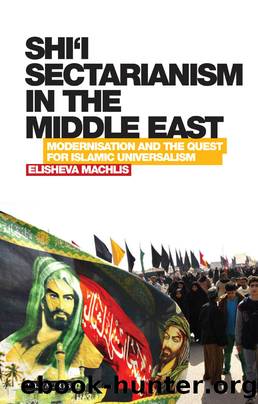Shi'i Sectarianism in the Middle East by Elisheva Machlis

Author:Elisheva Machlis [Machlis, Elisheva]
Language: eng
Format: epub
Tags: History, Middle East, General, Religion, Islam
ISBN: 9781786739513
Google: l7qKDwAAQBAJ
Publisher: Bloomsbury Publishing
Published: 2014-09-17T22:29:37+00:00
The Historical Political Discourse
Historically, two distinct approaches appeared in Sunni and Shiâi thought over the community's relationship with the ruling body. At the core of this disparity was a significant disagreement over the concept of authority. Sunnis sanctioned incumbent rulers even in cases in which these holders of power digressed from proper conduct, in order to avoid anarchy. Holders of power in the Sunni world also enjoyed backing from the religious establishment. The sovereign provided positions and financial backing to the âulamÄâ, while the clerics supported the leadership in its struggle against foreign enemies or internal rivals.4 By contrast, the traditional perception in Shiâism was that authority was invested in the leadership of the divinely-designated Imams.5 Only the IsmÄ'ilÄ« branch of Shiâism adopted a clear activist political inclination.6 The Twelversâ quietist approach resulted from the political reality of a vulnerable minority, which was later translated to the principle of taqiyya. Its ideological basis was rooted in the Occultation and the limits imposed on the community in the absence of the Imam. Following the Occultation, some Shiâi scholars permitted the clerics to obtain some of the Imams' roles and to cooperate with the holders of power on issues related to the welfare of the community. Moreover, in Iran, beginning from the sixteenth century, Shiâi scholars accepted a de-facto obedience to holders of power, similar to the Sunni view, as will be demonstrated below.
Historically within Twelver Shiâism, there was an early activist phase manifested in the battle between âAlÄ« and Muâawiya and the rising of ḥusayn against YazÄ«d. Yet it gave way to a more passive political tendency that dominated Shiâism since the Occultation. Twelver thought emphasised a remote rather than an imminent justice of God, which would be achieved on the Day of Judgment. The martyrdom of ḥusayn began to be perceived as a form of atonement and not as a model for militant struggle.7 Sorrows and suffering became the focus of Shiâi commemoration of the Prophet's family legacy. Numerous Shiâi Hadiths praise the virtue of weeping in memory of the Imams and particularly ḥusayn, the martyr of tears (qatÄ«l al-âabra).8
The suffering of the Imam became a paradigm of selfless sacrifice and proof of the Imam's lofty degree of piety and faith. Shiâis sought to emulate his model through acts of weeping, flagellation and re-enacting the Imam's martyrdom. This mode of commemoration was to bring salvation to the community on the Day of Judgment, on which the Imam was destined to intercede on their behalf.9 Yet, while chiliastic expectations did not totally disappear, a quietist inclination became the dominant feature of Twelver Shiâism. The clerics themselves sought to curb militant messianic tendencies by stressing the eschatological element of the Occultation and by emphasising that the Mahdi will return only in the indefinite future.10
In Iran, the Imami community balanced this other-worldly Shiâi view of religion, of awaiting passively for the return of the Imam, with a world embracing Sunni vision of Islam. Under the Safavids, who established Shiâism as the state religion, the clerics became absorbed by the state system.
Download
This site does not store any files on its server. We only index and link to content provided by other sites. Please contact the content providers to delete copyright contents if any and email us, we'll remove relevant links or contents immediately.
Never by Ken Follett(2878)
The Man Who Died Twice by Richard Osman(2297)
Machine Learning at Scale with H2O by Gregory Keys | David Whiting(2283)
Fairy Tale by Stephen King(2063)
Will by Will Smith(2040)
Reminders of Him: A Novel by Colleen Hoover(1877)
Rationality by Steven Pinker(1764)
The Stranger in the Lifeboat by Mitch Albom(1531)
The Becoming by Nora Roberts(1330)
Friends, Lovers, and the Big Terrible Thing by Matthew Perry(1326)
New Morning Mercies: A Daily Gospel Devotional by Paul David Tripp(1320)
A Short History of War by Jeremy Black(1299)
HBR's 10 Must Reads 2022 by Harvard Business Review(1253)
The Strength In Our Scars by Bianca Sparacino(1240)
The Fall of Babel by Josiah Bancroft(1233)
Can't Hurt Me: Master Your Mind and Defy the Odds - Clean Edition by David Goggins(1226)
515945210 by Unknown(1206)
Fear No Evil by James Patterson(1107)
Love on the Brain by Ali Hazelwood(1095)
